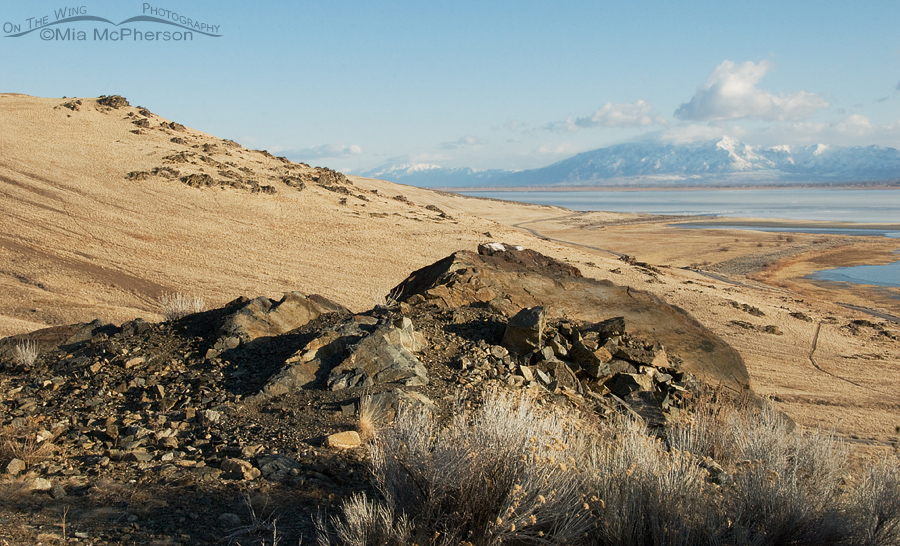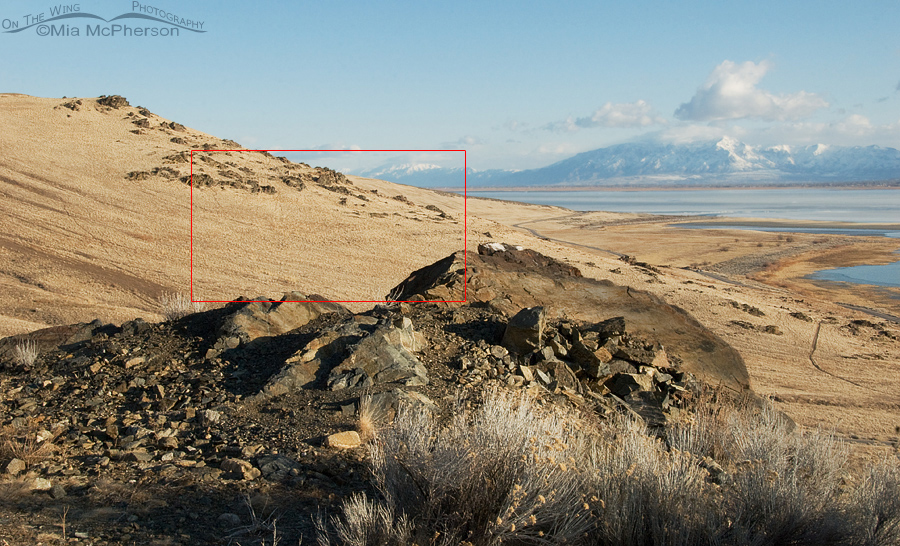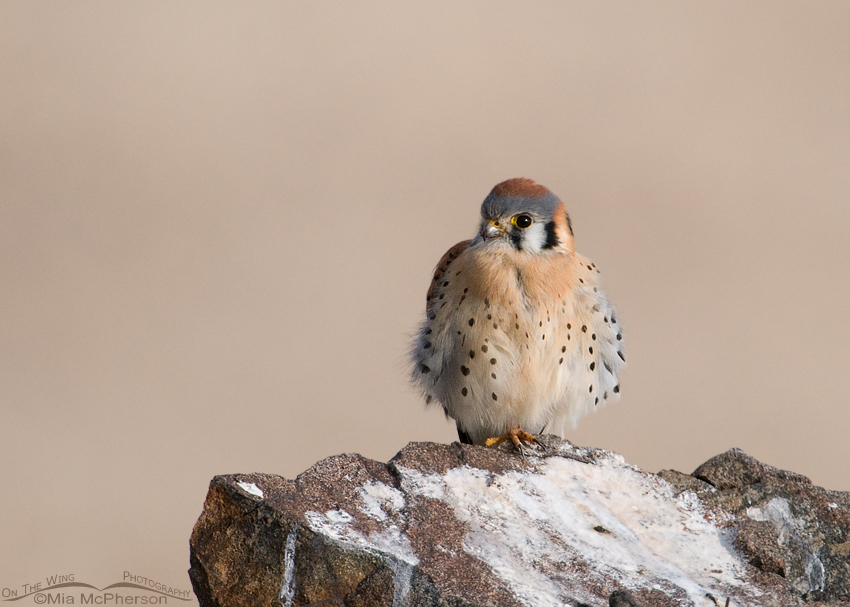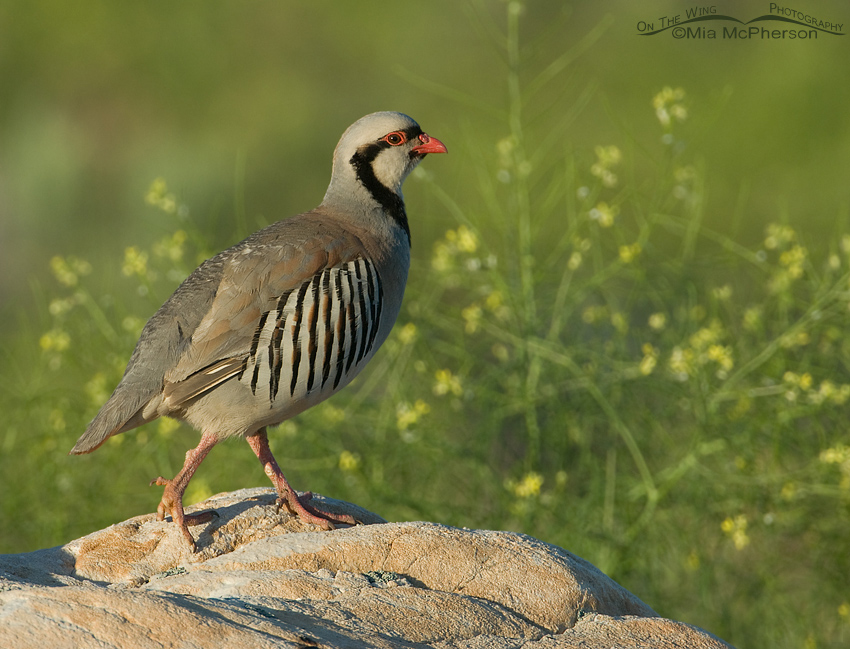 View from Frary Peak Trailhead, Antelope Island State Park – Nikon D200, handheld, f22, 1/125, ISO 400, -0.7 EV, Nikkor 18-200mm VR at 32mm
View from Frary Peak Trailhead, Antelope Island State Park – Nikon D200, handheld, f22, 1/125, ISO 400, -0.7 EV, Nikkor 18-200mm VR at 32mm
I’ve been asked on occasion how I have achieved very smooth backgrounds in my bird images, at times people have even asked if I have used a set up with a fake background such as painted canvas or plywood board hung behind an area where the birds are located. The reason they are called “set ups” is that it usually means that the birds have been baited or called in using repetitive sound recordings; or both, to entice or manipulate the subject into an area that has been artificially arranged to appear natural, sometimes the background is natural and other times people do use created backgrounds. Usually the background has a very smooth blur to it. Often the branch, stump, rock or other features that the birds are enticed to perch on have been selected from a natural area, removed and brought into the set up.
I don’t do set up shots, bait or call birds in using recordings because of my personal wildlife ethics but I can get the creamy smooth backgrounds often seen in set up shots while photographing in natural locations by knowing the location well, knowing the distance between the subject and the background features and selecting an aperture that will work the best for getting the degree of background blur desired.
I often find birds perched on the foreground rocky outcropping shown above when I am out in the field photographing on Antelope Island State Park in Utah. The rocks have lovely colors, texture and character, except for the whitewash of course but even that is natural although unappealing to some. Usually when I am photographing a bird on these rocks I am a bit closer and positioned slightly further to the east which is on the right side of this frame. I took this image specifically to show what was in the background of this setting and by using an aperture of f22 I have closely; or nearly perfectly, shown what the human eye would see of this scene which includes details, the texture of the rocks and variations in the topography of the hillside to the north.

In this duplicated photo I have outlined in red the general area that is normally behind these rocks when I am positioned further to the right to get a better angle of light on the subject. The “bokeh” of my lens and my choice of aperture will blur or smooth out the background behind the birds images posted below. There is no bokeh on these landscape images.
What is Bokeh?
“In photography, bokeh is the blur, or the aesthetic quality of the blur, in out-of-focus areas of an image, or “the way the lens renders out-of-focus points of light.” Differences in lens aberrations and aperture shape cause some lens designs to blur the image in a way that is pleasing to the eye, while others produce blurring that is unpleasant or distracting—”good” and “bad” bokeh, respectively. Bokeh occurs for parts of the scene that lie outside the depth of field. Photographers sometimes deliberately use a shallow focus technique to create images with prominent out-of-focus regions.
Bokeh is often most visible around small background highlights, such as specular reflections and light sources, which is why it is often associated with such areas. However, bokeh is not limited to highlights; blur occurs in all out-of-focus regions of the image.”
Source: Wikipedia
*Mirror Reflex lenses may be far less expensive than quality prime or zoom lenses but the bokeh of mirror reflex lenses is very unappealing and distracting in my opinion.
 American Kestrel (Falco sparverius) – Nikon D300, f6.3, 1/2500, ISO 800, Nikkor 200-400mm VR with 1.4x TC at 400mm, natural light, not baited
American Kestrel (Falco sparverius) – Nikon D300, f6.3, 1/2500, ISO 800, Nikkor 200-400mm VR with 1.4x TC at 400mm, natural light, not baited
This male American Kestrel was photographed on the rocky outcropping (just to the right of the red frame on the highest point in the image above) and it has a very smooth bokeh, in fact it would be extremely difficult to guess that there is a grassy slope behind the falcon. If I had photographed this at f22 some of the details, textures and topography would have been visible in the distance but since I used f6.3 and kept just the bird and the rock within my field of focus I have a silky smooth background.
 Adult Chukar on a rocky ledge – Nikon D300, f7.1, 1/640, ISO 1000, Nikkor 200-400mm VR with 1.4x TC at 400mm, low light
Adult Chukar on a rocky ledge – Nikon D300, f7.1, 1/640, ISO 1000, Nikkor 200-400mm VR with 1.4x TC at 400mm, low light
This Chukar was photographed yesterday on the same rock as the American Kestrel on a different day with low light, the Chukar is slightly larger than the falcon so I need just a bit more depth of field which is why I used f7.1. Again the background is nicely blurred. I can understand why some viewers might think this was a set up shot.
The grassy slope in the background is probably 1/4 to half a mile or so away, if the background features were much closer I would not be able to get the same featureless bokeh.
 Chukar on a rock with Black Mustard in the background – Nikon D200, f6.3, 1/500, ISO 400, Nikkor 200-400mm VR with 1.4x TC at 328mm, natural light
Chukar on a rock with Black Mustard in the background – Nikon D200, f6.3, 1/500, ISO 400, Nikkor 200-400mm VR with 1.4x TC at 328mm, natural light
So what happens when the background features are closer? In the image above the Chukar was on a rock with wild Black Mustard in the background, the mustard plants were far enough away that the bokeh blurred them but they are still recognizable as plant material. I would not call this a featureless bokeh and most viewers would not mistake it for a set up shot.
Do I prefer the featureless background bokeh over the one where the features are blurred but still recognizable? No, I love them both and appreciate each one individually.
For me; I want to be out in the field soaking in the wildness, observing birds doing what they do when they want to do it. I love the journey to the location. I want to absorb the peaceful feeling I get when I am immersed in the sounds, sights and smells and I want to learn as much as I can about my subject’s natural behavior and habitat. I relax behind the viewfinder and get a thrill when the action starts to happen. I’d miss out on all of that if I were to do set up shots so I’ll just keep on doing what I’ve been doing because it is my preference. And if that means I spends hours, days or even weeks waiting for the images I want out in the wild I just can’t think of a better way to spend my time!
Life is good.
Mia
For a depth of field and bokeh comparison of two Eagle images see this post: Bald Eagle and depth of field


More lovely photos, and good information too!
Thanks Linda, I love to photograph birds on that rocky outcropping because the background is so smooth.
Beautiful images, as always! Nice explanation of background choices!
Thanks Beverly, that location helps to create lovely backgrounds!
Lovely shots and very informative post Mia. Love how I learn as I enjoy your work.
Thanks Dan! 🙂
Odd, I just now commented on Ron’s pheasant photo, how I liked his background that to me, produced a nice bokeh effect. Now I read your article about the same subject. I am another one that wouldn’t dream of setting up a shot, or baiting, etc. I, like you, just shoot naturally as it comes, and with my 500mm f4 I shoot nearly wide open most of the time, and the lens usually gives me that nice blurred background. I do try to avoid having any distracting backgrond to begin with.
By the way, your photos above of the kestrel and the chukar, just blow my sox off. 🙂
Bob,
I see backyard feeders & images taken there as far different from the set ups I mentioned. I’m also careful about what is in the background when photographing.
Thanks for the comments on the kestrel and chukar shot on the rocks. I love it when I come up the hill and see a bird there!